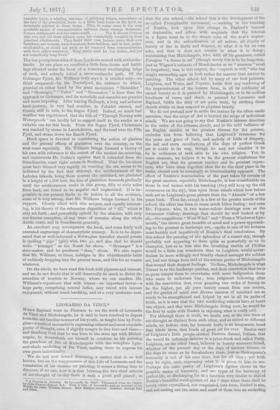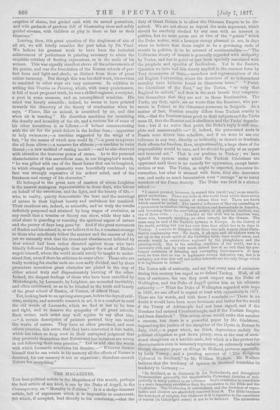LEONARDO DA VINCI.*
WREN Raphael went to Florence to see the work of Leonardo da Vinci and Michelangelo, he is said to have resolved to depart from the old familiar manner of his youth, as taught him by Peru- gino—a method successful in expressing calmest and most exquisite purity of thought, even if slightly meagre in line here and there— and thanking God that he was born in the same age with Michel- angelo, he thenceforth set himself to combine In his painting the grandeur of line of Michelangelo with the complete light- and-shade modelling of Da Vinci, uniting them to express his own great individuality.
We do not now intend discussing a matter that is so well known, but on the reappearance of this Lifo of Leonardo and the translation of his treatise on painting, it seems a fitting time to discover, if we can, how it is that between the two chief schools of art-thought of to-day there is such a great gulf placed ; so
* A Treatise on Painting. By Lnonardo da Vinci. Translated from the Italian hy John Promote Ithraud, It.A. With a Lire of Leonardo, and an Account of his Works, by John William Brown. New Edition, revised. London: Uoorge Boll and Bons. that the one school,—the school that is the development of the so-called Preraphaelite movement, — centring in the teaching of Ruskin, look upon this change in Raphael's manner as deplorable, and affirm with emphasis that the interest in a figure must be in the simple calm of the soul's expres- sion, and in the subordination of all action, all display of beauty of line in limbs and drapery, to what it is for its own sake, and that it does not consist in what it is doing ; maintaining that Michelangelo, who, with all his greatness, called Perugino "a dunce in art " (though surely this is to be forgotten, just as 'Wagner's estimate of Mendelssohn as an " amateur" must be forgotten), was, in this respect, the '' captain in evil," who has taught succeeding ages to look rather for manner than matter in painting. The other school, led by many of our best painters, Leighton, and Watts, and Poynter, holds that any rendering of the impressiveness of the human form, in all its sublimity of carnal beauty as it is painted by Michelangelo, or in its endless loveliness of curve and shade as painted. by Leonardo and Raphael, fulfils the duty of art quite truly, by striking those chords within us that respond to physical beauty.
We do not pretend now to settle the matter by the often-made assertion, that the scope of Art is beyond the scope of individual minds. We are not going to say that Ruskin's intense devotion to the order of the crimson clouds, and to the mild radiance of an English maiden as the greatest themes for the painter, excludes him from believing that Leighton's reverence for the poise and grace of limb, and melody of folds of drapery, the sad and stern recollections of the days of perfect Greek art is noble in its way, though he may not consider it to be in nobleness of rank akin to his own religion. Yet, in some measure, we believe it to be the gravest misfortune for English art, that its greatest teacher and its greatest expon- ents, who have risen together thus far to the chief place in its ranks, should now be seemingly so irreconeileably opposed, The effect of Ruskin's denunciation of the part taken by certain of the great masters, especially Michelangelo, is less considerable on those in real unison with his teaching (they still keep up the old reverences on the sly), than upon those minds which bow before such art as Leighton's great picture from the " Alcestis " of a few years back. Thus far, except in a few of the greater minds of the school, the effect has been to rouse much bitter feeling ; and even• Mr. Poynter, who, in two water-colour drawings now at the Grosvenor Gallery, drawings that should be well looked at by all,—the magnificent " West Wind " and " From a Window at Lyn- mouth," has shown great breadth of mind and a power approach- ing to the greatest in landscape art,—spoke in one of his lectures most harshly and impulsively of Ruskin's final conclusions. By this school the painting of the splendour of a sunset sky, though probably not appealing to them quite as powerfully as to its champion, just as to him also the breathing marble of Phidias would be a little less wondrous than to Leighton, would never- theless be more willingly and frankly classed amongst the noblest art, had not things been said of the solemn genius of Michelangelo, that wound their deepest feelings. To them, Michelangelo is what Turner is to the landscape-painter, and their conviction that he is so great tempts them to overwhelm with mere indignation those who seem to underrate him ; true judgment following after with the conviction that, even granting one order of beauty to be the higher, yet all pure beauty comes from one source, and the grades of mind and diverse natures of mankind are as. surely to be strengthened and helped by art in all its paths of' truth, as it is sure that the two conflicting schools have at heart one object, and that were Michelangelo living now, be would be the first to unite with Ruskin in rejecting what is really evil, For although there is truth, we doubt not, in the two lines of art-thought as distinct from each other, and as suited to different minds, we believe that, far beneath both, is an inseparable bond that binds them, that binds all great art for ever. Ruskin says of Leighton's little purple-clothed Eastern damsel, Fatima, that she would 1.5e infinitely daintier in a print-frock and called Patty. Leighton, on the other hand, believes in beauty wherever found, whether of the present day or the days of ancient Greece, or the days to come as he foreshadows them, just as Shakespeare's. humanity is not of his own time, but for all time ; yet both may be right, each expressing what it is given to him to see. Perhaps the calm purity of Leighton's figures shows us the possible states of humanity, and are types of the harmony of perfect life, so discharging for us a function very similar to that of Ruskin's beautiful word-picture of the " days when there shall be lovely cities crystallised, not coagulated, into form, limited in size, and not casting out the scum and scurf of them into an encircling
eruption of shame, but girded each with its sacred pomarium, and with garlands of gardens full of blossoming trees and softly guided streams, with children at play in them as fair as their blossoms."
Leaving, then, this great question of the singleness of aim of all art, we will briefly consider the part taken by Da Vinci, We believe his greatest work to have been the technical achievement of perfectness in painting necessary to attain the exquisite subtlety of fleeting expressions, as in the smile of his women. This was signally manifest above all the achievements of his genius, and was the foundation of the Roman schools of per- fect form and light-and-shade, as distinct from those of great colour-harmony. But though this was his chief work, his services to mankind in other ways are very numerous. In addition to writing this Treatise on Painting, which, with many quaintnesses, is full of most pregnant truth, he was a skilled engineer, a sculptor, a poet in some measure, and an accomplished musician. His mind was keenly scientific ; indeed, he seems to have pointed towards the discovery of the theory of combustion when be says, " Flame, like an animal, is nourished by air, and dies when air is wanting." He describes machines for measuring the density and humidity of the air, and a curious list of some of his other inventions is as follows :—A helmet communicating with the air for the pearl-fishers in the Indian Seas ;—apparatus to help swimmers ;—a machine suggested by the wings of a bat, " by the means of which men could fly ;"—a press to squeeze the oil from olives ;—a measure for ribbons ;—a machine to twist thread ;—a new method of casting medals ;—and he also observed with attention the immense power of steam. As to the personal characteristics of this marvellous man, in our biographer's words, " he was gifted with one of the finest forms that can be imagined, in which strength and symmetry were beautifully combined ; his face was strongly expressive of his ardent mind, and of the frankness and energy of his character."
He belonged to the great race of masters of whom Leighton is the nearest analogous representative in these days, who labour on behalf of the sweetness, and the light, and the beauty of life,— who, in reality, quietly demonstrate the laws and the meanings of nature in their highest beauty and usefulness for mankind. Their creations are, indeed, as scientific, and 'as truly the results definitely purposed and attained by long stages of evolution, as any result that a treatise or theory can show, while they take a chief share in guarding or rescuing the spiritual aspect of nature and the poetry of days long gone by. And if the great movement of Ruskin and his school is, as we believe it to be, a constant scourge to those who mindlessly follow the manner and the canons of Art, yet we earnestly wish that the trenchant chastisement inflicted by that school had been rather directed against those who have blindly followed Michelangelo than against the work of Michel- angelo himself, whom the world should surely be taught to under- stand first, even if there be criticism to come after. Those who are really working for similar ends are now sadly divided, and by these premature invectives groat obstacles are placed in the way of either school truly and dispassionately learning of the other. Indeed, the deepest feelings of those who have been ennobled by Michelangelo, by Leonardo, by Leighton, are wounded inevitably, and often embittered, so as to be blinded to the truth and beauty of the great school of Ruskin, of Turner, of Alfred Hunt.
Yet, looking back to an age long since past, before the days of criti- cism, analysis, and scientific research in art, it is a comfort to read the old words of Leonardo, which we find at last to be true and right, and to deserve the sympathy of all great schools. Each writer, each artist may well rejoice to say after him, -•••.■44 A. certain description of painters pretend they can mend the works of nature. They have so often practised, and seen others practise, this error, that they have converted it into habit, which has taken so deep root in their corrupted judgment' that they persuade themselves that Nature and her imitators are wrong in not following their own practice." Let us add also the words with which Leonardo concludes his treatise,—" Whoever flatters 'himself that he can retain in his memory all the effects of Nature is deceived, for our memory is not so capacious ; therefore consult Nature for everything."



































 Previous page
Previous page